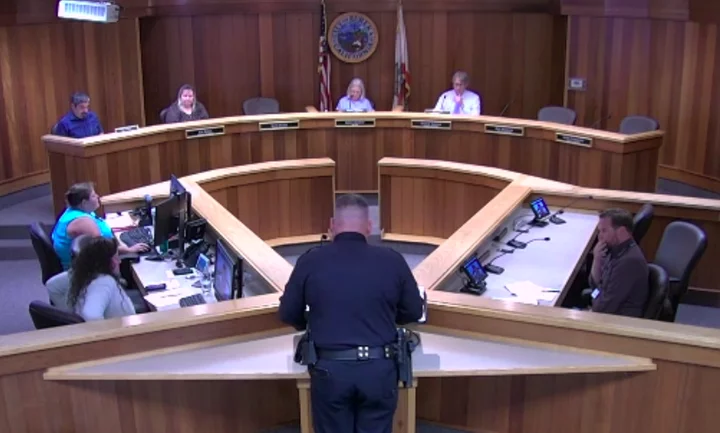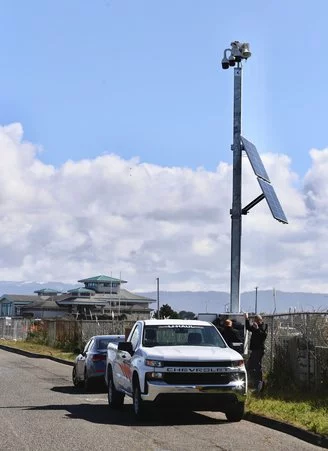
Screenshot of Tuesday’s Citizen Oversight of Police Practices board meeting.
###
Does Eureka have enough cops?
Not at all, according to information presented at the City of Eureka’s Citizen Oversight of Police Practices (COPP) board, which convened for its second quarterly meeting on Tuesday afternoon to discuss staffing and recruitment efforts at the Eureka Police Department.
Also discussed at the meeting of the city’s new police watchdog: How its members will be notified in the event an officer employs lethal force and what its role will be when that inevitably happens, and what is the city going to be doing with the security camera footage it will soon be collecting?
The COPP was formed earlier this year in response to the City Council’s request to beef up the Eureka Police Chief’s Citizen Advisory Board and enhance transparency and accountability within the department in the wake of the texting scandal. The City also hired Los Angeles-based consulting firm OIR Group to serve as the City’s Independent Police Auditor (IPA) and act as a conduit between the board and the department.
Police shootings and oversight
While reviewing the board’s draft bylaws during this week’s meeting, board member Mark Pardoe asked Michael Gennaco, founding principal of OIR Group, how he plans to communicate with the board in the event of a critical incident, such as an officer-involved shooting. Gennaco said his team would spring into action as soon as they became aware of the incident and would immediately notify the COPP board via text message.

Gennaco | Screenshot
“For example, in Anaheim, we are immediately notified of an in-custody death, officer-involved shooting or another critical incident, and then we work with the officer and the city manager to provide some preliminary information to the community-based review board about what has occurred,” he said. “We want you all to be informed of what is happening in your city regarding police involvement in a critical incident.”
OIR Group would continue to keep the board informed throughout the internal investigation process, but Gennaco emphasized that “these investigations are not completed overnight.”
“There are a lot of reasons for that,” he said. “…For example, if it’s an officer-involved shooting and it’s a fatality, the autopsy report that’s conducted, the toxicological report that’s conducted by the coroner’s office, all that information needs to be gathered by the detectives who are conducting the investigation. Eventually, that investigation is submitted to the district attorney for review and then there’s an internal review that’s conducted by [EPD] with regard to adherence to policy.”
Board Chair Melinda Ciarabellini asked whether any information would be made available to the public during the investigation process. It depends on the nature of the investigation, Gennaco said, but the matter would probably be taken up with the COPP board before any information went out to the public.
“That could vary and could depend a lot on what the initial information is, but there is certainly the ability to have special [or closed session] meetings, although I’m not sure that will be necessary in every case,” he added.
Following a brief exchange on the public notification process, the board unanimously agreed to adopt the draft bylaws in a 5-0 vote.
Staffing woes
Standing in for interim Police Chief Todd Jarvis, EPD Captain Brian Stephens provided the board with an update on staffing and recruitment efforts at the department. While staffing has improved over the last few months, nine of the 47 positions allotted under the 2022-23 budget year – minus the position of chief – remain vacant, he said.
“Of those positions, we have 32 working officers that are solo officers in the field or detectives. That breaks down to 22 sergeants and officers covering patrol, one of whom is currently on light duty,” he said. “In our detective bureau, [there is] one acting captain, one [Community Services and Engagement Team] sergeant [and] a waterfront ranger position that is funded by Measure Z.”
Stephens added that an officer position on the Mobile Intervention & Services Team (MIST), which is also funded by Measure Z, is in the process of being filled. There are also three police academy graduates going through EPD’s field training program who are expected to go solo by the end of October. Another three recruits are expected to graduate from the basic police academy in December. They could be solo officers on the street by next spring, he said.
There are three vacant positions in dispatch, one vacancy in community services and two vacancies in the records section. Both of the department’s animal control control officer positions are vacant as well, putting “quite a strain” on both the community and patrol officers.
“[There is] some good news,” Stephens said. “We purchased a new, dual purpose K9 that will go to Officer Jeremy Sollom. …His training will be completed by the first week of October and the dog has been named Yeti. …We’re currently fundraising for a second K9 that we hope to purchase in January. Our total goal would be to have…three patrol K9s and then we have a specialized narcotics, weapons and ammunition canine that does detection of those items.”
City Manager Miles Slattery jumped in to shed “a little positive light” on the City’s recruitment and retainment efforts. “A few months ago we were at about 13 officers down and we were looking at approximately two or three officers looking to go to another agency,” he said. “We worked really hard together as a team to retain and try to prevent people from leaving. …We’ve always had issues with maintaining staffing levels at EPD. We’re moving in the right direction.”
Gennaco added that police departments across the country have battled staffing shortages over the last few years.
“There are a lot of reasons for that,” he said. “The murder of George Floyd, subsequent protests and the defund policing movement. …The increased attention to policing has certainly created some pressure points with regard to those who are in the profession or those who may have otherwise wanted to get into the profession.”
Gennaco added that traditional incentives and long-term benefits offered to police officers aren’t as attractive to young people as they were in the past.
“[They’re] thinking, ‘I’m gonna try this for three or four years then I’m gonna try something else.’ They’re not interested in getting locked into a position and getting stuck,” he said. “That sort of runs contrary to the incentives that are traditionally provided police officers, which is the generous retirement and other other benefits that they accrue at the end of the career.”
The board accepted the staffing report but did not take a vote on the matter.
Those security cameras
The board also discussed the City’s new security camera use policy. The policy, which seeks to define the ways in which City-owned security cameras can be used, was adopted by the City Council earlier this month.
If you recall, the policy proposal came about after City staff erected an unsightly surveillance pole, popularly known as a “Lot Cop,” directly in front of Eureka’s Old Town gazebo without the council’s knowledge or approval. After a day of public outcry, staff agreed to move the pole behind the gazebo.

Mobile Lot Cop parked near the Wharfinger Building. | Photo: Andrew Goff
Before the thwarted attempt to install the security device at the Old Town gazebo, City staff parked mobile Lot Cops at various problem locations around town – near the Wharfinger Building and the Carter House, on Fifth Street downtown, along the Hikshari Trail corridor and elsewhere, and it proved successful in combating crime and undesirable behavior around town.
“Because of some of the staffing issues that we were seeing at EPD, we were looking at alternative ways to reduce calls for service and address problem areas,” Slattery explained told the board. “…We saw really good results [during our six month trial] with the mobile Lot Cops, especially in some of our problem areas, as well as some private locations that were having issues with vandalism and break ins.”
One of the main concerns brought up during the public process was the issue of constant surveillance, Slattery explained. He emphasized that the cameras will not be monitored 24/7, but will be used “for security purposes and oversight purposes to follow up on vandalism and crime” and could actually “exonerate people.”
Pardoe asked how much the Lot Cops would cost the City annually. The one-time cost for the polls and associated equipment was $20,000, Slattery said. The annual cost to keep the devices up and running is about $60,000.
Pardoe also asked who would have access to the security camera footage.
“It’ll be a limited number of folks that are designated by the city manager to view it,” Slattery said. “It won’t be open to all staff in any way, shape or form. There may be some exceptions but, for the most part, it will be the Public Works director, the EPD Community Services Director, and the police chief and captain.”
The board agreed to accept the report after a few additional questions but did not take a vote on the matter.
A recording of the meeting can be found here.
CLICK TO MANAGE